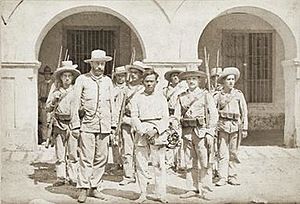Battle of Kakarong de Sili facts for kids
Quick facts for kids Battle of Kakarong de Sili |
|||||||||
|---|---|---|---|---|---|---|---|---|---|
| Part of the Philippine Revolution | |||||||||
 Maestrong Sebio after the battle. |
|||||||||
|
|||||||||
| Belligerents | |||||||||
|
|
|||||||||
| Commanders and leaders | |||||||||
| Strength | |||||||||
| 6,000 men, 1 fort | 600 Cazadores soldiers | ||||||||
| Casualties and losses | |||||||||
| 1,000+ killed, wounded, & captured (estimated) 1 fort |
24 killed, 76 wounded | ||||||||
The Battle of Kakarong de Sili happened on January 1, 1897, in Pandi, Bulacan, Philippines. This battle was a big fight during the Philippine Revolution. The Kakarong Republic, a small government set up by Filipino rebels, had a fort in Pandi. Spanish soldiers attacked this fort and defeated the Filipino fighters, known as Katipuneros. After the battle, General Eusebio Roque, also called Maestrong Sebio, was captured. The Kakarong Republic was special because it was the first republic (a type of government) created in Bulacan and in the Philippines.
Contents
What Led to the Battle
When the Philippine Revolution started, many Filipino fighters, called Katipuneros, wanted to join the fight against Spain. However, after a difficult battle near Manila, many Katipuneros in central Luzon felt discouraged. They decided to wait before starting their own revolts.
But in Pandi, Bulacan, and San Isidro, Nueva Ecija, the revolution was already strong. The Katipuneros in Bulacan formed their own government, the Kakarong Republic. They built a fort in the Real de Kakarong area. This fort was like a small city. It had streets, its own police, a military band, and even places to make weapons. They made knives called bolos and fixed rifles.
The Kakarong Republic had its own leaders. Canuto Villanueva was the Supreme Chief and military leader. Eusebio Roque, known as "Maestrong Sebio," was a general in the army. He was also the head of the local Katipunan group in Pandi.
The Battle Itself
On January 1, 1897, a large group of Spanish soldiers arrived at the fort. These soldiers were called "Cazadores." They were led by a commander named José Olaguer Feliú. There were about 600 Spanish soldiers. They surrounded the fort and started fighting Roque's and Gregorio del Pilar's forces.
The battle lasted for several hours. Eventually, the fort's walls were broken, and the Filipino fighters had to move deeper inside. After getting past the walls, the Spanish soldiers began burning down the buildings inside the fort. Many Katipuneros who were still there were defeated by the Spanish forces.
Gregorio del Pilar, who was a young officer at the time, was hurt. He and his remaining men managed to escape to a nearby village. Canuto Villanueva also got away. But Maestrong Sebio and many of his men were captured by the Spanish.
Maestrong Sebio was later executed by a firing squad on January 16, 1897. Even after this defeat, the province of Bulacan continued to be a center of rebellion. Filipino rebels there started using guerrilla tactics, which means they fought in small groups and used surprise attacks.
The Spanish commander, Olaguer Feliú, captured the fort and many weapons. The Spanish army lost 24 soldiers and had 76 wounded.
What Happened Next
Even though the Spanish won this battle, they could not completely stop the rebels in Bulacan. Many Filipino fighters who escaped the battle went to other towns and villages. They continued to fight using guerrilla warfare. The Spanish army did not have enough soldiers to completely stop the rebellion in Bulacan. Most of their soldiers were busy fighting rebels in other provinces like Manila, Rizal, Cavite, and Laguna.
Why This Battle is Important
The Battle of Kakarong de Sili was a very important experience for Gregorio del Pilar. It was his first big battle as a revolutionary general. The Kakarong Republic, even if not many historians remember it today, was the first organized republic in the Philippine Revolution. This means it was the first time Filipinos tried to set up their own independent government during the revolution.
In 1924, a group called the 'Legionarios del Trabajo' built a monument. It is called the Inang Filipina Shrine (Mother Philippines Shrine). They built it in memory of the 1,200 Katipuneros who died in the battle. This monument is in the Kakarong area of Pandi, Bulacan. The exact place where the battle happened is now part of Real de Kakarong.
Emilio Aguinaldo, who became the first president of the Philippines, visited this important site in the late 1950s.
Pictures of Kakarong de Sili
See also
 In Spanish: Caracong de Sile para niños
In Spanish: Caracong de Sile para niños



